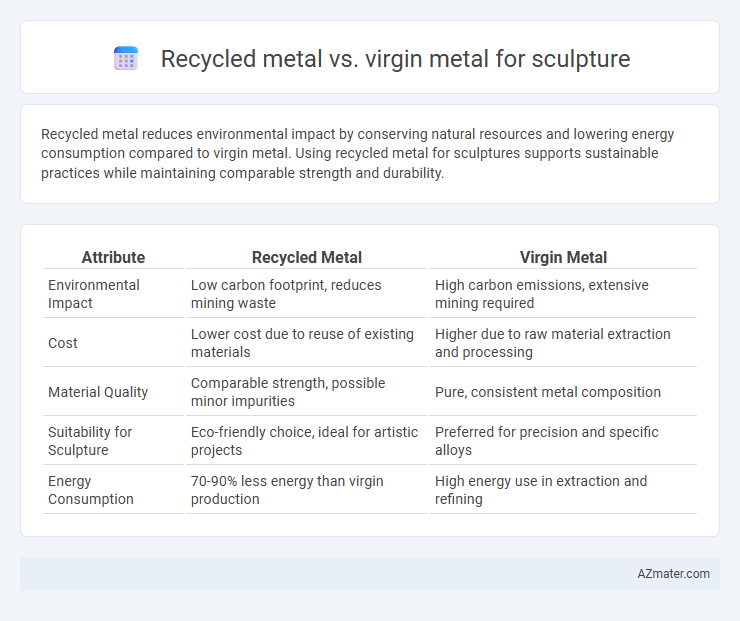Recycled metal reduces environmental impact by conserving natural resources and lowering energy consumption compared to virgin metal. Using recycled metal for sculptures supports sustainable practices while maintaining comparable strength and durability.
Table of Comparison
| Attribute | Recycled Metal | Virgin Metal |
|---|---|---|
| Environmental Impact | Low carbon footprint, reduces mining waste | High carbon emissions, extensive mining required |
| Cost | Lower cost due to reuse of existing materials | Higher due to raw material extraction and processing |
| Material Quality | Comparable strength, possible minor impurities | Pure, consistent metal composition |
| Suitability for Sculpture | Eco-friendly choice, ideal for artistic projects | Preferred for precision and specific alloys |
| Energy Consumption | 70-90% less energy than virgin production | High energy use in extraction and refining |
Introduction to Metal Choices in Sculpture
Recycled metal offers sustainable and cost-effective options for sculpture, reducing environmental impact by repurposing existing materials like aluminum, steel, and copper. Virgin metal provides superior purity, strength, and malleability essential for detailed and durable artwork, often favored for high-quality, long-lasting sculptures. Selecting between recycled and virgin metal depends on the artist's priorities in sustainability, budget, and the desired physical properties of the sculpture.
Defining Recycled Metal and Virgin Metal
Recycled metal refers to metal materials that have been reclaimed from scrap or used products, melted down, and repurposed for new creations, offering a sustainable alternative to virgin metal. Virgin metal is extracted directly from ore through mining and refining processes, providing pure, unprocessed raw material ideal for sculptural applications requiring high structural integrity. Choosing between recycled and virgin metal impacts environmental footprint, cost, and material properties critical in sculpture production.
Environmental Impact: Recycled vs Virgin Metal
Recycled metal significantly reduces environmental impact by conserving natural resources and lowering energy consumption, emitting up to 95% less CO2 compared to virgin metal extraction and processing. Mining virgin metals contributes to habitat destruction, soil erosion, and water pollution, whereas recycled metals minimize these ecological disturbances. Sculptors choosing recycled metals support sustainable practices by reducing landfill waste and decreasing the carbon footprint associated with metal production.
Cost Comparison: Recycled vs Virgin Metal
Recycled metal costs significantly less than virgin metal due to lower extraction and processing expenses, making it a budget-friendly choice for sculptures. Virgin metal requires energy-intensive mining and refining, driving up overall prices compared to recycled alternatives. Choosing recycled metal not only reduces material costs but also supports sustainable practices without compromising structural integrity.
Material Quality and Durability
Recycled metal used in sculptures often retains high material quality due to modern refining techniques that eliminate impurities, making it comparable to virgin metal in strength and appearance. Virgin metal, extracted and processed directly from ore, typically offers consistent purity and structural integrity, enhancing durability in detailed or large-scale sculptures. Both recycled and virgin metals provide excellent longevity, but recycled metals contribute to sustainability without compromising the sculpture's resilience and aesthetic value.
Creative Potential and Aesthetic Differences
Recycled metal offers unique patinas and textures that enhance the creative potential of sculptures by providing diverse color variations and weathered finishes not typically found in virgin metal. Virgin metal, with its uniformity and purity, allows for more precise shaping and consistent surface quality, which can be crucial for achieving refined, polished aesthetics. Artists often select recycled metal to express sustainability themes or to introduce organic imperfections, while virgin metal is favored for sleek, modern designs demanding high structural integrity.
Availability and Sourcing Challenges
Recycled metal offers greater availability and lower environmental impact compared to virgin metal, as it relies on repurposing existing materials from scrap yards and industrial waste, reducing the need for mining. Virgin metal sourcing involves extensive extraction processes that are often limited by geopolitical factors, regulatory restrictions, and fluctuating market demand, posing challenges in consistent supply. Artists prioritizing sustainability might prefer recycled metal due to its abundance and reduced ecological footprint, while virgin metal presents quality and purity advantages but with sourcing uncertainties.
Sustainability Considerations in Metal Sculpture
Recycled metal significantly reduces environmental impact by lowering energy consumption and greenhouse gas emissions compared to virgin metal extraction in metal sculpture creation. Utilizing recycled metals supports sustainable resource management by minimizing mining waste and preserving natural ecosystems. Artists incorporating recycled metal contribute to circular economy principles, enhancing the ecological footprint of their sculptures.
Case Studies: Artists Using Recycled vs Virgin Metal
Case studies reveal artists like El Anatsui who create large-scale sculptures using recycled metal, showcasing sustainability and unique textures derived from discarded materials. In contrast, Jeff Koons' works utilizing virgin metals emphasize precision, durability, and a polished finish, reflecting contemporary industrial techniques. The choice between recycled and virgin metal influences artistic expression, environmental impact, and material aesthetics in sculpture creation.
Making the Right Choice for Your Sculpture Project
Choosing between recycled metal and virgin metal for your sculpture project hinges on factors like environmental impact, cost, and desired finish quality. Recycled metal offers sustainability benefits by reducing the carbon footprint and conserving natural resources while often being more cost-effective. Virgin metal provides unmatched purity and consistency, ensuring optimal structural integrity and surface appearance essential for intricate or large-scale sculptures.

Infographic: Recycled metal vs Virgin metal for Sculpture
 azmater.com
azmater.com